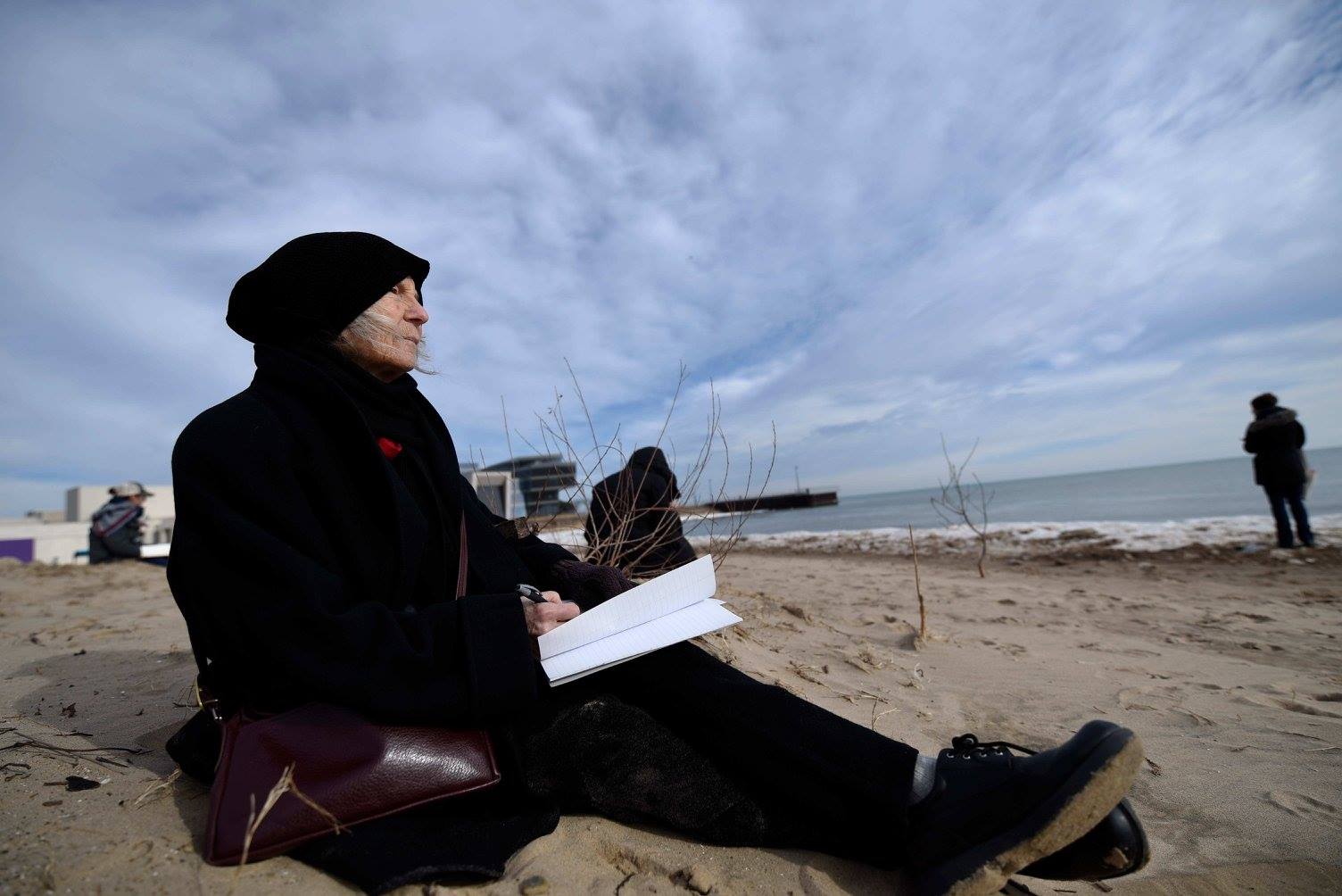
“Thinking with the Body,” a workshop with Simone Forti, at Northwestern University, hosted by the Mary & Leigh Block Museum of Art, in relation to the exhibition A Feast of Astonishments: Charlotte Moorman and the Avant-Garde, 1960s–1980s. The workshops were hosted in partnership with Northwestern’s Departments of Art History, Art Theory & Practice, and Performance Studies; the Dance Program; Mellon Dance Studies; and the Poetry & Poetics Colloquium. (Simone Forti)
During a talk organized in conjunction with the exhibition A Feast of Astonishments: Charlotte Moorman and the Avant-Garde, 1960s–1980s, at Northwestern University’s Mary and Leigh Block Museum of Art, Simone Forti touched on the breadth of her work as a writer, dancer, choreographer, and teacher. As she spoke, students performed one of Forti’s seminal works, Huddle and read excerpted compositions made during a two-day, movement-and-creative-writing workshop. The combined effect of her conversation and this tableau captured the fluidity of Forti’s career, as she flowed effortlessly between spoken language, embodied movement, and introspection. The interview below followed Forti’s presentation; the accompanying images feature students who participated in the workshop.
Caroline Picard: During your talk, you referred to Anna Halprin as your mother and John Cage as your father. I know that you’ve also explored a lot of animal movement in your work; does that interest also come from Cage and Halprin?
Simone Forti: In the 1950s, Anna was teaching dance improvisation, always with a point of reference. She had us observe a lot of movements and forms in nature and improvise to explore aspects of what we had observed. My movement vocabulary in the 1970s was very much based on my observations of animals in the zoo, both their gaits and the games some animals invented for passing time in their limited environment. I came to see movement play as a root of dance behavior.
CP: What role does architecture play in that scheme? For instance, you described working primarily on Halprin’s outdoor deck in Marin County, north of San Francisco. I’m curious to know how that setting might have contrasted with dance or performance movements inspired by New York City.
SF: I once read a translated Chinese poem, in which I found the line, “I go to the garden to open my heart.” Dancing on Anna’s deck in the woods brought a lot of joy. And I’ve sometimes thought of the way we moved as being akin to how the abstract expressionists painted. When my then husband, Robert Morris, and I moved to New York, I remarked on how everything my gaze fell on had been designed by people. [The world] felt like a house of mirrors. Through Robert Dunn’s composition class at the Merce Cunningham studio, I became acquainted with the work and the thinking of John Cage. And I was able to think up the Dance Constructions, which gave me a feeling of my simple weight and mass and non-stylized movement.
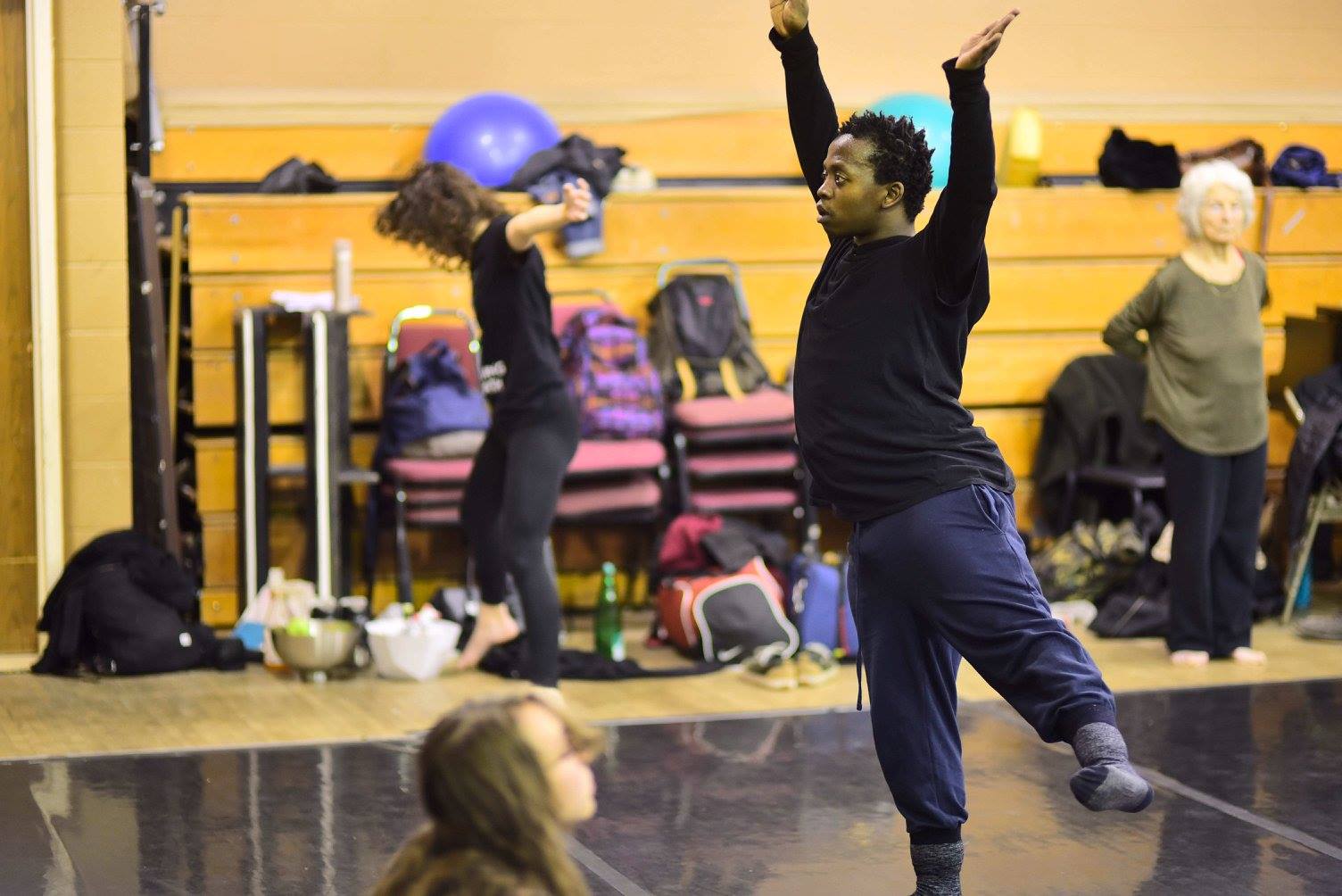
“Thinking with the Body,” a workshop with Simone Forti, at Northwestern University, hosted by the Mary & Leigh Block Museum of Art, in relation to the exhibition A Feast of Astonishments: Charlotte Moorman and the Avant-Garde, 1960s–1980s. The workshops were hosted in partnership with Northwestern’s Departments of Art History, Art Theory & Practice, and Performance Studies; the Dance Program; Mellon Dance Studies; and the Poetry & Poetics Colloquium.
CP: Much of the Block Museum’s exhibition captures the atmosphere of New York avant-garde theater and music festivals. How did those events inform your own practice?
SF: I lived and worked in a large community of artists and took it for granted that I too was making art. So the avant-garde festivals were part of my world but not a very close part. During the span of the festivals, I was closer to the community that formed around the Happenings (with people like Robert Whitman, Claes Oldenburg, Jim Dine, and Allan Kaprow) and the dance community (including Yvonne Rainer, Steve Paxton, and Trisha Brown) than I was to the Fluxus group. I was also close to Jackson Mac Low and La Monte Young. I was close to Nam June Paik primarily because we lived in the same co-op. And he later invited me to participate in three of his video operas.
[In the exhibition,] it’s fun to see us all so young, to see the look of those days. Above all, it is wonderful to see images of Charlotte doing amazing things. Of course, I was aware of her in those days but not so aware of the many things she had done.
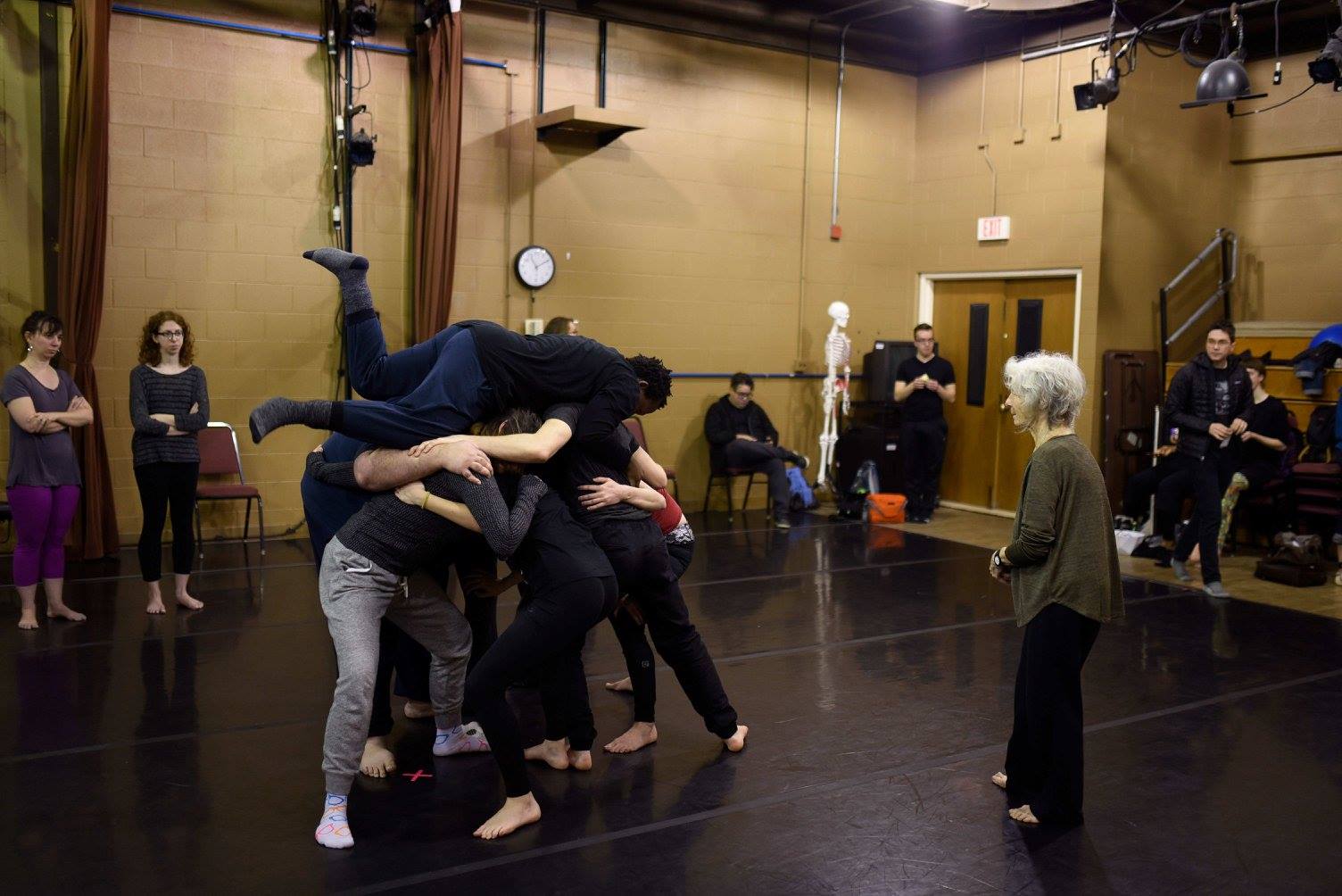
“Thinking with the Body,” a workshop with Simone Forti, at Northwestern University, hosted by the Mary & Leigh Block Museum of Art, in relation to the exhibition A Feast of Astonishments: Charlotte Moorman and the Avant-Garde, 1960s–1980s. The workshops were hosted in partnership with Northwestern’s Departments of Art History, Art Theory & Practice, and Performance Studies; the Dance Program; Mellon Dance Studies; and the Poetry & Poetics Colloquium.
CP: Does that New York avant-garde culture of artists relate to your statement, “We are in a landscape now, taking turns changing the landscape”? I have a sense you are interested in looking at the interrelationship of mind and body, that thought and movement always necessarily correspond. It occurred to me that groups of people working together would make another corresponding environment or landscape.
SF: That’s wonderful. The verbal mind and body mind do work together; it’s something we all experience but have difficulty finding words to explain. I like including people working together in that cycle of influences, of course.
CP: Handbook in Motion is a collection of your writings that presents presumably natural moments, like a polar bear on an ice floe, with seemingly equivalent moments, in which a man in pajamas walks up to a tree and changes his posture. You write lush descriptions of Woodstock as a landscape, populated not just by people but also by supposedly inanimate things: “Objects, though moved by people, seemed to follow their own path, to be part of the flow.” Your work emerges within this assembly, whether as collaborative performance-based games or descriptions of works. It seems like you are suggesting that one can embody a large view—of collective participation, for instance—while exercising minute and very specific movements in a single instant.
SF: I have the impression that—even as I try not to think but to experience a microsecond of being between thoughts—I still sense un-thought thoughts, ready to burst into structured thought. I think we’re aware of a lot of things at once. I like to cut back and forth between my point of focus and the mosaic of my peripheral awareness. I cultivate this and work with it in my improvised moving-and-speaking News Animation performances. I find these jumps of focus a lot easier to do while I’m freely moving; maybe the movement is a kind of distraction. When I lived in Vermont, I loved working in my kitchen garden. I learned that worms in the earth stay clean and herbs tend to invade other herbs’ territories. If during a News Animation performance—maybe while twisting together how different cultures have different views of their history and of events in the present—I place my hand on the floor, that contact suddenly recalls the feel of bumping into a potato in the ground. Moving and putting words to observations, questions, anguish, and humor is a way of paying attention and of keeping one’s thoughts fluid and responsive.
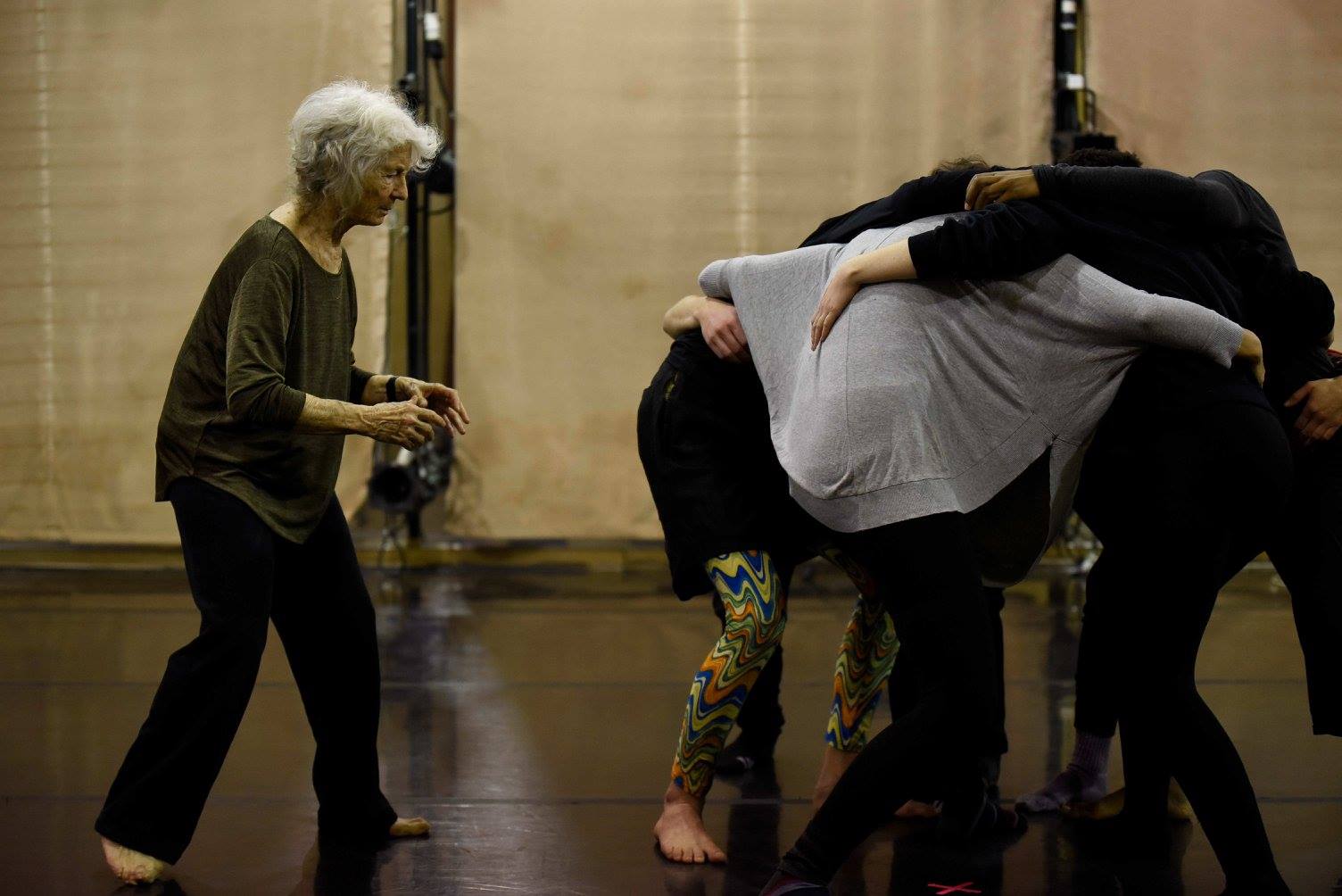
“Thinking with the Body,” a workshop with Simone Forti, at Northwestern University, hosted by the Mary & Leigh Block Museum of Art, in relation to the exhibition A Feast of Astonishments: Charlotte Moorman and the Avant-Garde, 1960s–1980s. The workshops were hosted in partnership with Northwestern’s Departments of Art History, Art Theory & Practice, and Performance Studies; the Dance Program; Mellon Dance Studies; and the Poetry & Poetics Colloquium.
CP: Can you talk about Saburo Murakami’s 1956 piece, Sakuhin (Tsuka) [Work (Paper Break Through)], particularly the role of built-in resistance? I feel like Huddle incorporates a similar functional resistance: the figures within the group have to hold their positions in order to allow another peer to climb over them. Similarly the piece Slant Board uses the tension between the incline of the ground, gravity, and a body interacting with ropes.
SF: Resistance. Like getting your teeth into good dark bread and tearing off a hunk of it. When I was a kid I loved wrestling. Huddle and Slant Board [are psychologically satisfying in that way]. When I arrived in New York, I felt the need to push against something solid. I had heard that John Cage wanted to be able to hear sound purely, without the distraction of stylistic expectations, and that his use of chance operations was in part a device that surprised him and let him hear a sound in and of itself. From that, I learned that if you need something, you can create a situation that lets you fill that need.
CP: But how do you identify a need so that others can participate in its fulfillment?
SF: When I made the Dance Constructions, I don’t think I could have articulated what I needed or that I knew that these pieces could help me. I think that a lot of my creative decisions came from my body: “Ugh. Me climb.” What I say about it now is in retrospect and should be taken with a grain of salt. But I find it interesting that, about the time I moved from improvising (which I eventually returned to and which has been my primary mode over the years) to the more conceptual Dance Constructions, abstract-expressionist painting was less in vogue as minimalism came into focus.
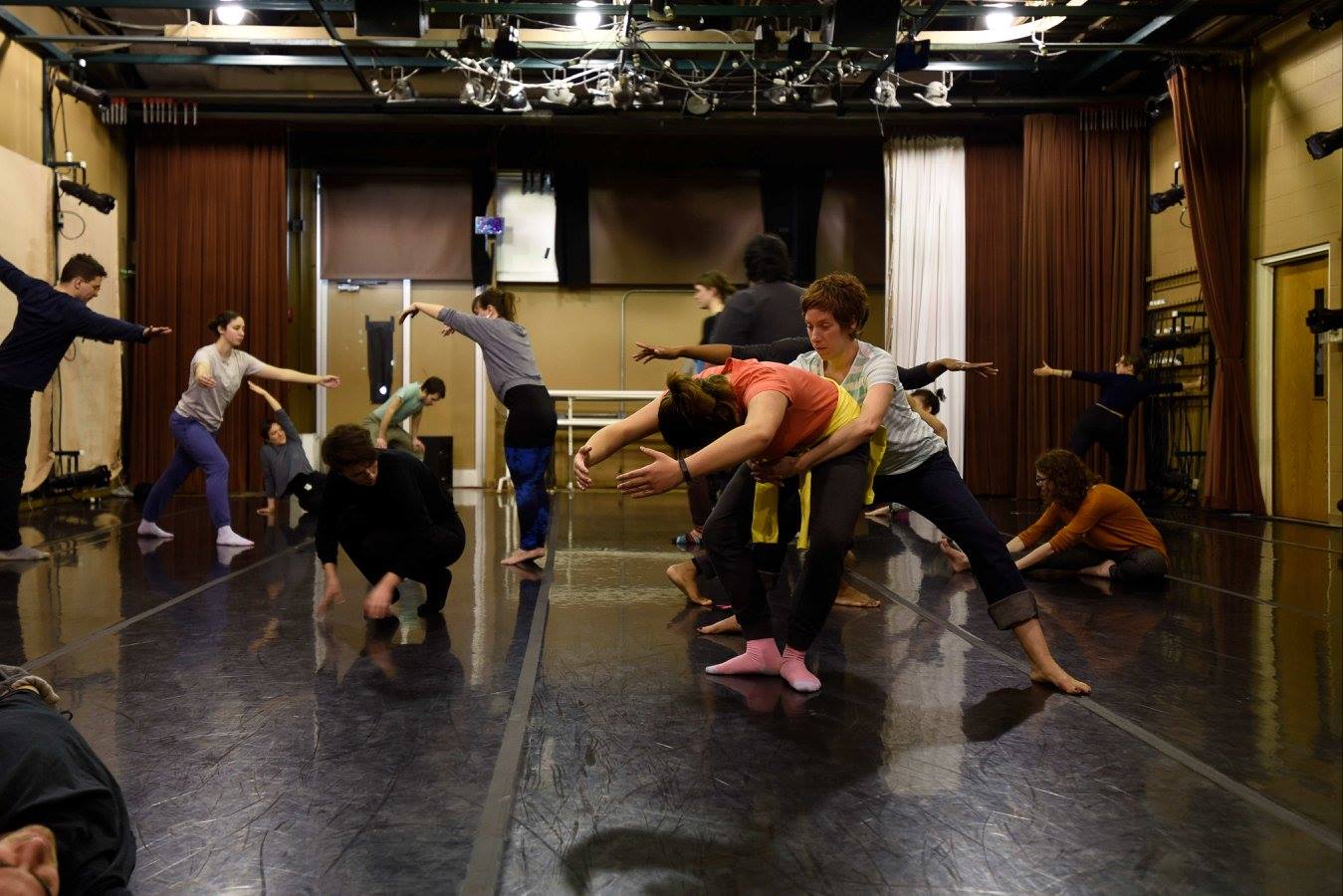
“Thinking with the Body,” a workshop with Simone Forti, at Northwestern University, hosted by the Mary & Leigh Block Museum of Art, in relation to the exhibition A Feast of Astonishments: Charlotte Moorman and the Avant-Garde, 1960s–1980s. The workshops were hosted in partnership with Northwestern’s Departments of Art History, Art Theory & Practice, and Performance Studies; the Dance Program; Mellon Dance Studies; and the Poetry & Poetics Colloquium.
CP: What does it feel like, to return to your early work?
SF: I mainly see young people learning to perform the Dance Constructions. They find the work meaningful, and that’s joyful to me. I can stand aside and see that the pieces are beautiful. There’s something solid about them. I feel that a young artist can get a footing against them and push off into new territory.
The Dance Constructions have been influential in both the art and the dance world, and I trust that they continue to be valuable by engaging us in a discourse. Each is a separate idea. For the viewer, each allows us to see the direct beauty of people simply in action. For the performer, there is the enjoyment of participating with others in an action that is simple and direct while being part of a whole with complex implications. Not all of the Dance Constructions work with resistance. In Platforms, two performers lie under boxes and whistle a tone on each exhale.
CP: Breath is such an intangible yet omnipresent activity. I love the way it centers one’s attention, on the present.
SF: I think of Platforms as a domestic piece. I see the two performers as lovers, asleep, each in their own dream world yet hearing each other breathe.

“Thinking with the Body,” a workshop with Simone Forti, at Northwestern University, hosted by the Mary & Leigh Block Museum of Art, in relation to the exhibition A Feast of Astonishments: Charlotte Moorman and the Avant-Garde, 1960s–1980s. The workshops were hosted in partnership with Northwestern’s Departments of Art History, Art Theory & Practice, and Performance Studies; the Dance Program; Mellon Dance Studies; and the Poetry & Poetics Colloquium.



